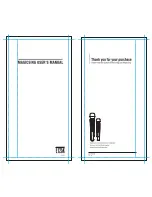
____________________________________________________________________
_______________________________________________________________________
MN0090-05 Page 11 of 68 18008
MPT-90 PRODUCT MANUAL
This document contains U.S. export controlled technical data as regulated by the U.S. Export Administration Regulations 15 CFR Parts 730-774, export, disclosure or transfer contrary to U.S. law is prohibited.
2.4
Drive
The drive mechanism consists of two 1.8° stepper motors, driven by a 10:1
micro-step motor driver. The motor drivers are provided with DC source
voltage, and enable, direction and pulse signals. 2000 pulses are required for
the motor to turn 1 revolution. Each motor has a 12 tooth sprocket to drive the
worm-carriers via a chain drive. The chain is tensioned with an adjustable
idler, and the chains drive the carriers mentioned above. The pan carrier uses
a 28 tooth sprocket where the tilt uses a 30 tooth sprocket, giving the tilt a
slight increase in ratio reduction.
2.5
Electronics
The controller provides two fundamental types of moves: open loop “jog”
moves where the user specifies direction and velocity, and automated moves
where the controller is managing the move.
Stepper motors require starting at a nominally low speed, and may then be
accelerated by increasing the frequency of the pulse to the motor driver. In jog
mode, the unit will begin a move at a pre-determined speed and accelerate to
the commanded speed. When the jog command is terminated, the pulses
stop quickly decrease in frequency to zero, preventing an abrupt stop.
In automated moves, the microcontroller determines which direction it must
go, then manages the move by controlling acceleration, running at the
commanded speed during the move while monitoring position. The start
speed, acceleration rate and maximum move speed are user adjustable.
When the unit arrives at a pre-determined distance from the commanded
position, a deceleration process begins, slowing the unit to a stop at the
intended destination. User may set the distance from the final destination
where the slow down process starts. These adjustments allow the user to
tailor the motion profile to optimize for the type and size of the payload. For
example, you may wish to position a short range camera system with more
aggressive moves than a satellite dish, due to its size. A more complete
description of adjustments is in the protocol manual.
Additional electronic capabilities provide inner-connections between the
multiple serial ports on the unit, allowing the user to command the positioner
and payloads using various command methods.












































